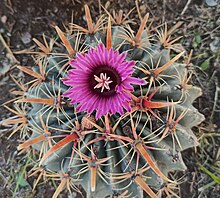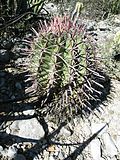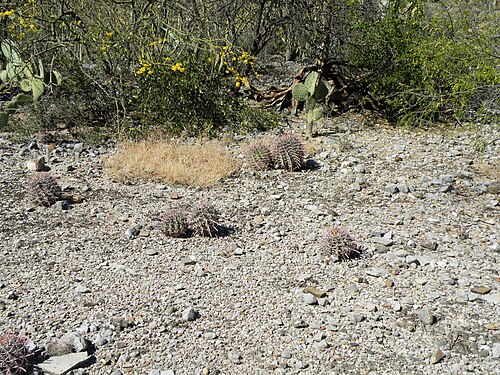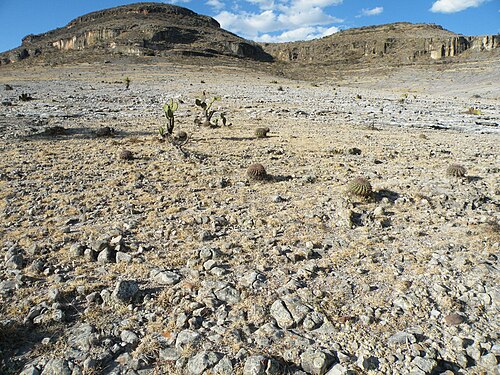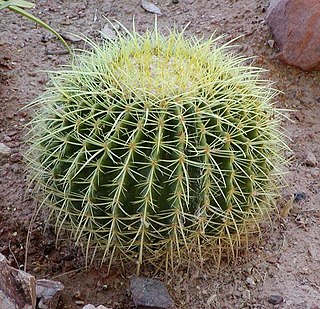
Barrel cacti are various members of the two genera Echinocactus and Ferocactus, endemic to the deserts of Southwestern North America southward to north central Mexico. Some of the largest specimens are found in the Sonoran Desert.

Echinocactus is a genus of cacti in the subfamily Cactoideae. The generic name derives from the Ancient Greek ἐχῖνος (echînos), meaning "spiny," and cactus. It and Ferocactus are the two genera of barrel cactus. Members of the genus usually have heavy spination and relatively small flowers. The fruits are copiously woolly, and this is one major distinction between Echinocactus and Ferocactus. Propagation is by seed.

Kroenleinia grusonii, popularly known as the golden barrel cactus, golden ball or mother-in-law's cushion, is a species of barrel cactus which is endemic to east-central Mexico.
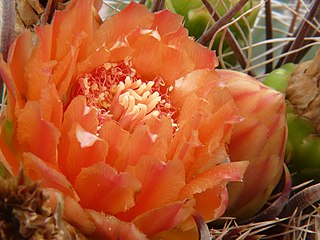
Ferocactus wislizeni, the fishhook barrel cactus, also called Arizona barrel cactus, candy barrel cactus, and Southwestern barrel cactus, is a species of flowering plant in the cactus family Cactaceae, native to northern Mexico and the southern United States. It is a ball-shaped cactus eventually growing to a cylindrical shape, with spiny ribs and red or yellow flowers in summer.

Ferocactus cylindraceus is a species of barrel cactus which is known by several common names, including California barrel cactus, Desert barrel cactus, compass barrel cactus, and miner's compass. It was first described by George Engelmann in 1853.

Ferocactus echidne is a barrel cactus in the genus Ferocactus. It is found in nature in Mexico. This cactus is known commonly as Sonora barrel, Coville's barrel cactus, Emory's barrel cactus, and traveler's friend. This plant is often sold as a houseplant.

Ferocactus viridescens is a species of flowering plant in the cactus family Cactaceae. This rare barrel cactus is known by several common names, including coast barrel cactus, keg cactus and San Diego barrel cactus. Most of its native range in the United States is in San Diego County, California, where it is threatened by development, agriculture, and other alterations in its habitat. It is also found in northern Baja California, Mexico.
Didymium wildpretii is a species of slime mold which feeds on the decaying remains of various species of cacti. It was first described in 2007 and has been found across Mexico and the Canary Islands, but may be present where other cacti grow. Its sporocarps are short ; their sporotheca is pale yellow with an orange stalk and their spores have a diameter of 7.5 μm. When grown on agar, it completes its life cycle in 28–56 days. It grows on basic media with a pH of 7.8–10.0, with optimum growth occurring at 8.5–9.4. The species was named after Wolfredo Wildpret de la Torre, an expert in the flora of the Canary Islands.

Ferocactus emoryi, known commonly as Emory's barrel cactus, Coville's barrel cactus and traveler's friend, is a barrel cactus in the genus Ferocactus.

Thelocactus setispinus, commonly known as miniature barrel cactus or hedgehog cactus, is a species of cactus in the family Cactaceae.

Ferocactus fordii is a species of succulent plant in the family Cactaceae, commonly known as Ford's barrel cactus, endemic to the Baja California Peninsula of Mexico. It is spherical, growing to 50 cm (20 in) in diameter, with whitish-grey radial spines and solitary flowers of a deep rose pink, 4 cm (2 in) in diameter.

Ferocactus hamatacanthus, commonly named Turk's Head, is a barrel cactus in the tribe Cacteae.

Ferocactus chrysacanthus, commonly known as the Cedros barrel cactus, is an endangered species of cactus endemic to the islands of Cedros and West San Benito off the Pacific coast of Baja California, Mexico. It is a solitary-stemmed barrel cactus with a globose to short cylindrical shape, and grows to 1 m (3.3 ft) tall. The yellow to orange flowers bloom from June to July, and mature into yellow fruits. Sometimes recognized is the subspecies grandiflorus, which has orange to red flowers up to 6 cm (2.4 in) long and is native to the Vizcaíno Peninsula of Baja California Sur.

Ferocactus diguetii, commonly known as the giant barrel cactus, is the largest species of barrel cactus in the genus Ferocactus. It is an insular species endemic to several of Baja California Sur's southern islands in the Gulf of California. As the superlative giant of the barrel cacti, it reaches heights of up to 4 metres (13 ft) and diameters of 1 metre (3.3 ft) in the wild, a result of island gigantism. The species has red flowers that bloom from March to May. Although restricted in range, this species grows in protected habitat and lacks major threats.

Ferocactus townsendianus, commonly known as the Townsend barrel cactus, is a species of cactus endemic to southern Baja California Sur in Mexico. It is a barrel cactus that grows solitary stems up to 1 metre (3.3 ft) tall, with gray to brown spines, with one central spine on each areole usually curved or hooked at the tip, and orange to red flowers that bloom from May to August. Ferocactus townsendianus is similar to both Ferocactus peninsulae and Ferocactus santa-maria, and is sometimes placed under peninsulae as a variety or subspecies.

Ferocactus histrix, also known as Acitrón barrel cactus is a species of Ferocactus native to central Mexico. It is a large barrel cactus that can be commonly found throughout all the Central Mexican matorral. It produces an edible fruit appreciated for its sour taste.
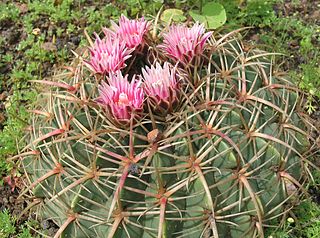
Ferocactus macrodiscus is a species of cactus in the genus Ferocactus from Guanahuato and Oaxaca States, Mexico.

Polaskia chende is a succulent cactus native to a small area of mountains of northern Oaxaca and southern Puebla, Mexico. It grows in xerophytic shrubland between 1,500 and 2,000 meters above sea level.

Ferocactus herrerae, commonly known as the twisted barrel cactus, Herrera's barrel cactus, or the biznaga, is a species of viviparous barrel cactus in the genus Ferocactus of the family Cactaceae that is native to southwestern Sonora to the northwestern coastline of Sinaloa in western Mexico. It was described by Mexican botanist, Jesús González Ortega in 1927. Its common name refers to its twisted, barrel cactus shape habit, with long, hooked, or barbed spines.

Pachycereus weberi is a columnar cactus plant native to Mexico.
